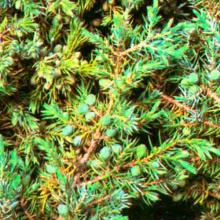Juniperus communis
Common name:
Common juniper
Genus:
Juniperus
Family:
Cupressaceae
Order:
Pinidae
Thuja occidentalis
Common name:
Eastern white cedar
Genus:
Thuja
Family:
Cupressaceae
Order:
Pinidae
Juniperus communis
Common name:
Common juniper
Genus:
Juniperus
Family:
Cupressaceae
Order:
Pinidae
Thuja occidentalis
Common name:
Eastern white cedar
Genus:
Thuja
Family:
Cupressaceae
Order:
Pinidae
Juniperus communis
Common name:
Common juniper
Genus:
Juniperus
Family:
Cupressaceae
Order:
Pinidae
Thuja occidentalis
Common name:
Eastern white cedar
Genus:
Thuja
Family:
Cupressaceae
Order:
Pinidae
Family (Plantae): Cupressaceae
Cupressaceae is a conifer family, the cypress family, with worldwide distribution. The family includes 27–30 genera (17 monotypic), which include the junipers and redwoods, with about 130–140 species in total. They are monoecious, subdioecious or (rarely) dioecious trees and shrubs up to 116 m (381 ft) tall. The bark of mature trees is commonly orange- to red- brown and of stringy texture, often flaking or peeling in vertical strips, but smooth, scaly or hard and square-cracked in some species.
Description
The leaves are arranged either spirally, in decussate pairs (opposite pairs, each pair at 90° to the previous pair) or in decussate whorls of three or four, depending on the genus. On young plants, the leaves are needle-like, becoming small and scale-like on mature plants of many genera; some genera and species retain needle-like leaves throughout their lives. Old leaves are mostly not shed individually, but in small sprays of foliage (cladoptosis); exceptions are leaves on the shoots that develop into branches. These leaves eventually fall off individually when the bark starts to flake. Most are evergreen with the leaves persisting 2–10 years, but three genera (Glyptostrobus, Metasequoia and Taxodium) are deciduous or include deciduous species.
The seed cones are either woody, leathery, or (in Juniperus) berry-like and fleshy, with one to several ovules per scale. The bract scale and ovuliferous scale are fused together except at the apex, where the bract scale is often visible as a short spine (often called an umbo) on the ovuliferous scale. As with the foliage, the cone scales are arranged spirally, decussate (opposite) or whorled, depending on the genus. The seeds are mostly small and somewhat flattened, with two narrow wings, one down each side of the seed; rarely (e.g. Actinostrobus) triangular in section with three wings; in some genera (e.g. Glyptostrobus and Libocedrus), one of the wings is significantly larger than the other, and in some others (e.g. Juniperus, Microbiota, Platycladus, and Taxodium) the seed is larger and wingless. The seedlings usually have two cotyledons, but in some species up to six. The pollen cones are more uniform in structure across the family, 1–20 mm long, with the scales again arranged spirally, decussate (opposite) or whorled, depending on the genus; they may be borne singly at the apex of a shoot (most genera), in the leaf axils (Cryptomeria), in dense clusters (Cunninghamia and Juniperus drupacea), or on discrete long pendulous panicle-like shoots (Metasequoia and Taxodium).
Cupressaceae is a widely distributed conifer family, with a near-global range in all continents except for Antarctica, stretching from 71°N in arctic Norway (Juniperus communis) south to 55°S in southernmost Chile (Pilgerodendron uviferum), while Juniperus indica reaches 5200 m altitude in Tibet, the highest altitude reported for any woody plant. Most habitats on land are occupied, with the exceptions of polar tundra and tropical lowland rainforest (though several species are important components of temperate rainforests and tropical highland cloud forests); they are also rare in deserts, with only a few species able to tolerate severe drought, notably Cupressus dupreziana in the central Sahara. Despite the wide overall distribution, many genera and species show very restricted relictual distributions, and many are endangered species.
Reference: Wikipedia


